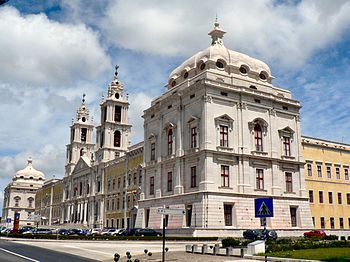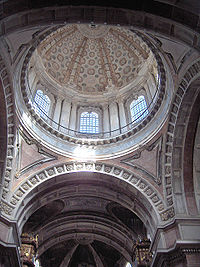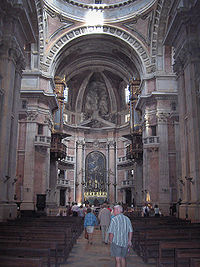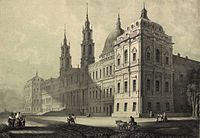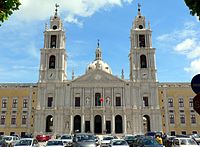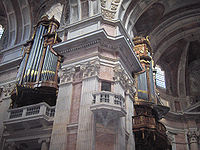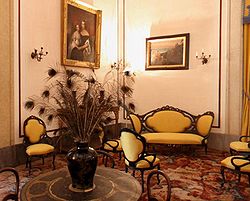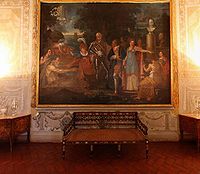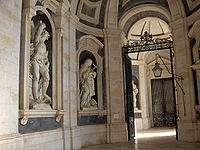- Mafra National Palace
-
Coordinates: 38°56′12″N 9°19′35″W / 38.93667°N 9.32639°W The Mafra National Palace is a monumental Baroque and Italianized Neoclassical palace-monastery located in Mafra, Portugal. Its dimensions are so huge that it dwarfs the city. The palace-monastery is said to be Portugal's attempt to rival the Spanish palace at Escorial outside Madrid, Spain, but was built more like a response to the power of the Vatican, having the monastery a similar loom to the Pope's official residence.
The palace, which also served as a Franciscan monastery, was built during the reign of King John V (1707–1750), in consequence of a vow made by the king in 1711, who promised to build a convent if his wife, the Queen Mary Anne of Austria, gave him descendants. The birth of his first daughter, the princess Barbara of Braganza, made the king initiate the construction of the palace.
This vast complex is among the most sumptuous Baroque buildings in Portugal and one of the biggest buildings constructed in Europe in the 18th century. The palace was built symmetrically from a central axis, occupied by the basilica, and continues lengthwise through the main façade until two major towers. The structures of the convent are located behind the main façade. The building also includes a major library, with about 40,000 rare books.
The basilica is decorated with several Italian statues and includes six historical pipe organs and two carillons, composed of 92 bells.
Contents
Construction
The exact site was chosen in 1713 and purchased in 1716. Construction began by the laying of the first stone on November 17, 1717 with a grand ceremony in the presence of the king, his entire court and the Cardinal Patriarch of Lisbon.
Initially it was a meager project for a convent of 13 Capuchin friars, who were to observe strict poverty. However, when the flow of gold from Brazil started to arrive in Lisbon in abundance, the king changed his plans and announced the construction of a sumptuous palace[1] along with a much enlarged convent. This immense wealth allowed to king to be a generous patron of arts – the greatest patron of his time according to historians.
He appointed a German goldsmith Johann Friedrich Ludwig (called by the Portuguese : João Frederico Ludovice) as his architect. He had studied architecture in Rome and knew contemporary Italian art. The extent of Ludwig's responsibility is unclear, as several other architects were involved in this project : the Milanese builder Carlos Baptista Garbo, Custódio Vieira, Manuel da Maia and even his own son António. However the application of the same architecture over the whole building suggests the work of Ludwig as the head-architect in charge of the Royal Works (Real Obra).
The construction lasted 13 years and mobilized a vast army of workers from the entire country (a daily average of 15,000 but at the end climbing to 30,000 and a maximum of 45,000), under the command of António Ludovice, the son of the architect. In addition 7,000 soldiers were assigned to preserve order at the construction site. They used 400 kg of gunpowder to blast through the rocks for the laying of foundations. There was even a hospital for the sick or wounded workers. A total of 1,383 workers died during the construction.
The facade is 220 meters long. The whole complex covers 37,790 m² with about 1,200 rooms, more than 4,700 doors and windows, and 156 stairways.
At the end, the building consisted of a convent, capable of sheltering 330 friars, along with a royal palace and a huge library of 40,000 books, embellished with marble, exotic woods and countless pieces of art, taken from France, Flanders and Italy, which included six monumental pipe organs and the two carillons.
The basilica and the convent were inaugurated on the day of the King's 41st anniversary, October 22, 1730. The festivities lasted for 8 days and were of a scale never seen before in Portugal. The basilica was dedicated to Our Lady and to St. Anthony.
However the building wasn't finished. The lantern on the cupola was completed in 1735. Work continued till 1755, when the work force was needed in Lisbon by the devastations of the Great Earthquake
History
The palace wasn't occupied permanently by the royalty, who considered the rooms too gloomy. Nonetheless, it was a popular destination for the members of the royal family who enjoyed hunting in the nearby game preserve, the Tapada Nacional de Mafra.
During the reign of king John VI the palace was inhabited for a whole year in 1807. The king was responsible for a partial renovation of the building by some well-known artists. However, with the French invasion of Portugal, in 1808, the royal family fled to Brazil, taking with them some of the best pieces of art and furniture in the building. Marshall Junot took up residence in the palace, to be driven out in turn by Wellington.
In 1834, after the Liberal Wars, Queen Maria II ordered the dissolution of the religious orders and the convent was abandoned by the Franciscans. During the last reigns of the House of Braganza, the palace kept being used as a hunt resort. In 1849 the monastery part of the building was assigned to the military, a situation still in use today.
The last king of Portugal, Manuel II, following the proclamation of the republic, departed on 5 October 1910 from the palace to the nearby coastal village of Ericeira on his way to exile.
The palace was declared a national monument in 1907. At present, the building is conserved by the Portuguese Institute of the Architectonic Patrimony, which carried out several recovery programs, including the conservation of the main façade. A major restoration of the historical pipe organs began in the 1990s with the collaboration of foreign experts.
Description
Façade
The imposing façade, built of local limestone, is 220 m long and faces the town of Mafra. At each end of the façade stands a square tower with a bulbous dome, such as found in Central Europe. The church, built in white marble, is located in the centre of the main façade, symmetrically flanked on both sides by the royal palace.
The king, wishing to rival the splendour of Rome, had sought architectural advice from his ambassador to the Vatican, who sent him small-scale models of important Roman religious buildings. The benedictial balcony at its centre is clearly mirrored on the balcony of St. Peter's Basilica in Rome. But this balcony is rather intended for the king, as a symbol of his power, than for the benedictions by a prelate.
The two church towers (68 m high) are inspired by the towers of Sant'Agnese in Agone (by the Roman Baroque architect Francesco Borromini). Their two carillons contain a total of 92 church bells, founded in Antwerp. The story goes that the Flemish bell-founders were so astonished by the size of their commission, that they asked to be paid in advance. The king retorted by doubling the offered amount. These carillons constitute the largest historical collection in the world.
The two towers are connected by two rows of Corinthian columns. The top row contains the statues of St. Dominic and St. Francis, sculpted out of Carrara marble, standing in a niche on each side of the balcony. The lower row contains the statues of St. Anne and St. Elisabeth of Hungary.
Basilica
The church is built in the form of a Latin cross with a length of 63 m. It is rather narrow (16.5 m), an impression accentuated by the height of its nave (21.5 m).
The vestibule (Galilee porch) contains a group of large sculptures in Carrara marble, representing the patron saints of several monastic orders.
The interior makes abundantly use of local rose-coloured marble, intermingled with white marble in different patterns. The multi-coloured designs of the floor are repeated on the ceiling. The barrel vault rests on fluted Corinthian semicolumns standing between the side chapels. The chapels in the transept contain altarpieces in jasper made by sculptors from the School of Mafra. The side aisles display 58 marble statues commissioned from the best Roman sculptors of their time. The All Saint's chapel in the transept is screened from the crossing by iron railings with bronze ornaments, made in Antwerp.
The choir has a magnificent giant candleholder with seven lamps sprouting from the mouth of seven rolled-up snakes. Above the main altar, inserting into the ceiling, is a gigantic jasper crucifix of 4.2 m, flanked by two kneeling angels, made by the School of Mafra.
The cupola over the crossing was also inspired by the cupola of Sant'Agnese in Agone (by the Roman Baroque architect Francesco Borromini). This 70 m-high cupola with a small lantern atop, is carried by four finely sculpted arcs in rose and white marble.
There are six organs, four of which are located in the transept, constituting a rather uncommon ensemble. There were built by Joaquim Peres Fontanes and António Xavier Machado Cerveira between 1792 and 1807 (when the French troops occupied Mafra). They were made out of partially gilded Brazilian wood. The largest pipe is 6 m high and has a diameter of 0.28 m.
King John V had commissioned liturgical vestments from master embroiderers from Genoa and Milan, such as Giuliano Saturni and Benedetto Salandri, and from France. They attest of superb quality and workmanship by their embroidering in gold technique and the use of silk thread in the same colour.
The religious paintings in the basilica and the convent constitute one of the most significant 18th century collections in Portugal. They include works by the Italians Agostino Masucci, Corrado Giaquinto, Angelo Trevisani, Pompeo Batoni and some Portuguese students in Rome such as Vieira Lusitano and Inácio de Oliveira Bernardes.
The sculpture collection has works by almost every major Roman sculpturer from the first half of the 18th century. At that time, it represented the biggest single order done by a foreign power in Rome and still is amongst one of the biggest collections in existence.
Monastery
The rectangle behind the church and the palace houses the monastery of the Franciscan monks of Arrábida Order (Ordem de São Francisco da Província da Arrábida) with cells for about 300 friars in long corridors on several floors. Between 1771 and 1791 this monastery was occupied by the Hermit Friars of St. Augustine.
Royal Palace
The spacious royal apartments are situated on the second floor. The apartments of the king are situated at the end of the palace while the apartment of the queen is 200 m away at the other end. Such was this distance that, when the king left his apartment towards the apartment of the queen, this was announced to the queen by the sound of a trumpet.
As king John VI had taken with him some of the best pieces of art and furniture in the building when the royal family fled in 1808 for the advancing French troops to Brazil, most rooms had to be redecorated in the original style.
The Hunting trophy room (Sala dos Troféus) is decorated with numerous skulls of deer, the furniture is constructed of antlers and covered with deerskin and even the candleholders are made of deer antlers.
The Benediction Gallery (Sala da Benção) borders at the upper level of the basilica. The royal family could here attend Mass, seated at a window opening unto the basilica. The bust of John V in this hall is a work of the Italian Alessandro Giusti.
The Throne Room, the Guard Room and the Room of Goddess Diana are decorated with murals by artist such as Ciryllo Wolkmar Machado, Bernardo Oliveira Góis and Vieira Lusitano.
Library
The Rococo library, situated at the back of the second floor, is truly the highlight of this palace, rivalling the grandeur of the library of the Melk Abbey in Austria. Built by Manuel Caetano de Sousa, this library is 88 m long, 9.5 m wide and 13 m high. The magnificent floor is covered with tiles of rose, grey and white marble. The wooden bookshelves in Rococo style are situated on the sidewalls in two rows, separated by a balcony with a wooden railing. They contain over 35,000 leather-bound volumes, attesting of the extent of western knowledge from the 14th to the 19th century. Among them, are many valuable bibliographical jewels, such as incunabula. These beautiful finished volumes were bound in the local workshop (Livraria) in the rocaille style (also by Manuel Caetano de Sousa).
Besides natural techniques of conservation for the books, such as the lack of space between the wall and the book (so it doesn't create humidity), there are also a few bats that inhabit this library eating any insect that could destroy this invaluable treasure.
The Library was used in Gulliver's Travels (1996) as the Great Chamber of War for the Emperor of Lilliput.
Legends
There are several legends regarding the palace. The most popular claims that giant rats, capable of eating people inhabit the palace and leave it at night in order to kill what they can, cats, dogs and people. The origin of this legend is the large sewer system built below the palace. Another legend speaks about the existence of a secret tunnel, linking Mafra to Ericeira and that King Manuel II used the tunnel to escape the exile and remained in Portugal.
There are also many alleged connections between the Palace's location and the mythology surrounding the Fifth Empire. [1]
Appearances in literature
A major reference to the construction of the palace is made in the book Baltasar and Blimunda (Memorial do Convento), written by the Portuguese Nobel laureate José Saramago. The main character, Baltasar, born in Mafra, works in the construction of the palace. Saramago makes a detailed description of the building process, including the transport of a giant stone from the quarry to the building site, depicting it as a torture for those who helped building the palace.
Mafra School of Sculpture
The Mafra School of Sculpture was founded during the reign of king Joseph I of Portugal, successor of king John V. As the Mafra National Palace had a great need for sculptors, local and from abroad, it became the location of a sculpture academy headed by the Italian Alessandro Giusti (1715–1799). Among the teachers were several important sculptors, such as José de Almeida (1709–1769), Claude de Laprade (1682–1738) and Giovanni Antonio da Padova (who created most of the statues for the cathedral of Évora). The academy was awarded many commissions by the Augustinians from the monastery, resulting in the many marble statues and retables in marble and jasper in the basilica.
This academy produced several generations of Portuguese sculptors, such as Joaquim Machado de Castro (1731–1822).
References
- (Portuguese) "Palácio e Convento de Mafra". Instituto Português do Património Arquitectónico. http://www.ippar.pt/monumentos/palacio_mafra.html. Retrieved 2006-07-10.
- (Portuguese) "Convento de Mafra". http://www.malhatlantica.pt/convento_mafra/. Retrieved 2006-07-10.
- Turner, J. – Grove Dictionary of Art – Oxford University Press, USA; New Ed (January 2, 1996); ISBN 0-19-517068-7
- Rentes de Carvalho J. – Portugal, um guia para amigos (in Dutch translation : Portugal); De Arbeiderspers, Amsterdam; 9th ed. August 1999; ISBN 90-295-3466-4
- The Rough Guide to Portugal – 11th ed. March 2005; ISBN 1-84353-438-X
- The National Palace of Mafra, an English guide; IPPAR, July 2005 (on sale in the palace)
See also
- List of Baroque residences
Notes
- ^ The construction of the palace was so costly that it consumed virtually all of the Brazilian gold, which might otherwise have been used to benefit the general economy of Portugal. Toby Green, Inquisition: The Reign of Fear, p. 315.
External links
 Media related to Palácio Nacional de Mafra at Wikimedia CommonsCategories:
Media related to Palácio Nacional de Mafra at Wikimedia CommonsCategories:- 18th-century architecture
- Palaces in Portugal
- Royal residences in Portugal
- Basilica churches in Portugal
- Neoclassical architecture in Portugal
- Neoclassical palaces
- Baroque architecture in Portugal
- Baroque palaces
Wikimedia Foundation. 2010.

